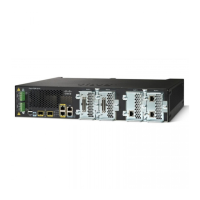31-27
Catalyst 3550 Multilayer Switch Software Configuration Guide
78-11194-09
Chapter 31 Configuring IP Unicast Routing
Configuring IGRP
To shut down an IGRP routing process, use the no router igrp global configuration command.
This example shows how to configure a router for IGRP and assign it AS 109. The network router
configuration commands show the networks directly connected to the router.
Switch(config)# router igrp 109
Switch(config-router)# network 131.108.0.0
Switch(config-router)# network 192.31.7.0
Step 8
timers basic update invalid holddown
flush [sleeptime]
(Optional) Adjust routing protocol timers.
• update—The time (in seconds) between sending of routing updates.
The default is 90 seconds.
• invalid—The timer interval (in seconds) after which a route is declared
invalid. The default is 270 seconds.
• holddown—The time (in seconds) during which routing information
about better paths is suppressed. The default is 280 seconds.
• flush—The time (in seconds) that must pass before a route is removed
from the routing table. The default is 630 seconds.
• sleeptime—Interval in milliseconds for postponing routing updates.
The default is 0.
Step 9
no metric holddown (Optional) Disable the IGRP hold-down period. The route to a network is
placed in holddown if the router learns that the network is farther away than
previously known or is down. Holddown keeps new routing information
from being used for a certain period of time and prevents routing loops
caused by slow convergence. This command disables holddown, which
increases the network's ability to quickly respond to topology changes.
Use the metric holddown command only if other routers or access servers
within the IGRP AS are not configured with the no metric holddown
command. If all routers are not configured the same way, you increase the
possibility of routing loops.
Step 10
metric maximum-hops hops (Optional) Configure the maximum network diameter. Routes with hop
counts exceeding this diameter are not advertised. The default is 100 hops;
the maximum is 255 hops.
Step 11
no validate-update-source (Optional) Disable validation of the source IP address of incoming routing
updates. By default, the switch validates the source IP address of incoming
routing updates and discards the update if the source address is not valid.
Step 12
variance multiplier (Optional) Define the variance associated with a particular path to enable
unequal-cost load balancing if desired, balancing traffic across all feasible
paths to converge to a new path if a path should fail. The multiplier can be
from 1 to 128; the default is 1 (equal-cost load balancing).
Step 13
traffic-share {balanced | min} (Optional) Distribute traffic by one of these methods:
• balanced—Proportionately to the ratios of metrics
• min—By the minimum-cost route.
Step 14
end Return to privileged EXEC mode.
Step 15
show ip protocols Verify your entries.
Step 16
copy running-config startup-config (Optional) Save your entries in the configuration file.
Command Purpose

